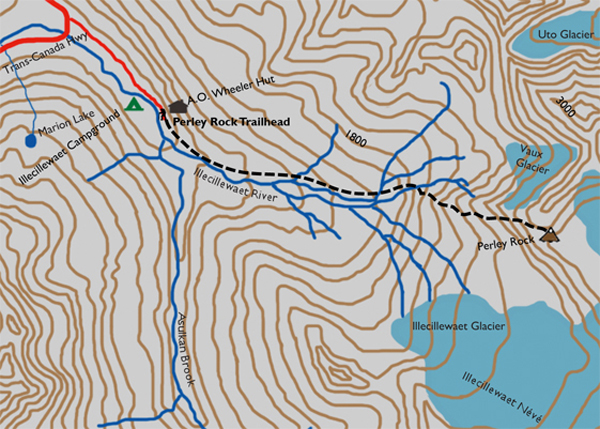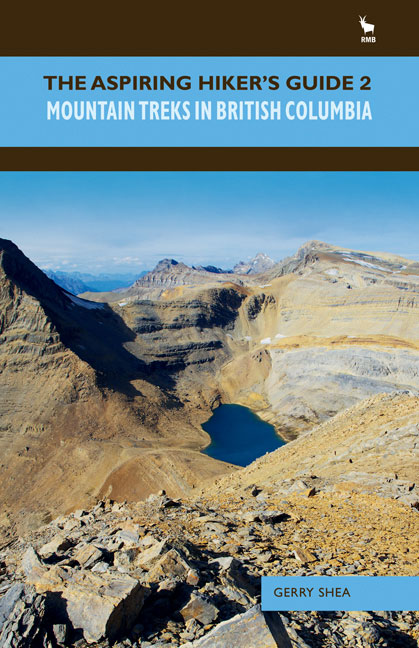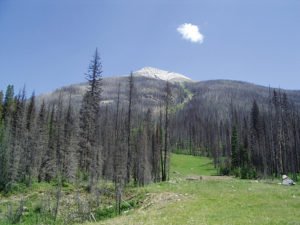Distance
After you’ve crossed the second bridge, all that is left are switchbacks. However, the higher you go, the more incredible the scenery becomes. Mountain peaks and ranges that cradle glaciers surround the valley they feed. Below, small glacier ponds and the scrape marks left behind by the receding glaciers become evident as the path winds upward. Some 15 to 20 minutes more and the trail will reach a fork where the routes are clearly marked. Sir Donald Trail carries on to the left, Perley Rock to the right. Take the right branch and activate your climbing legs once more.
The path from the junction begins as steep switchbacks through a thin forest of spruce and fir. This persistent uphill grunt takes you beyond the trees when the route leaves the forest for the alpine. Open talus slopes become part of the landscape as the upward grind continues. Finally, an impressive snow slope sits directly in your path and the ledge of Perley Rock seems within your grasp. The snow can be intimidating, and I have seen hikers clamber way down to the base of it, only to climb all the way back up on the opposite side. This is quite understandable because one slip at the top of the snow slope will send you sliding downward, out of control, possibly all the way to the bottom. And where the snow ends, the rocks take over. So be careful. An ice axe or hiking staff comes in handy here for balance.
Beyond the snow slope, cairns mark the way through rocks and small boulders. It will require one last burst of energy to scramble to the wide base of the enormous rock outcropping known as Perley Rock.
Everything seen from this chunk of the planet is, quite frankly, just big. Illecillewaet Névé, Mount Sir Donald, Lookout Mountain, the Illecillewaet Valley, even the sky – all are enormous. Everywhere you look the beauty is immense.
Perley Rock history
Glacier House, Mount Stephen House at Field and Fraser Canyon House at North Bend, BC, were all constructed to accommodate tourists along the CPR route. These three facilities were built out of necessity rather than choice, as these locations created substantial hardship for locomotives hauling dining cars and sleeping cars up and down the steep grades.
Perley Rock is named after Harry Allison Perley, the first manager of Glacier House before it became a popular CPR stop. After railway construction was completed, there was still an abundance of work to do on snowsheds, stations, yards, terminals and the organization of schedules and operations. All this effort was going to take significant time to complete, but the railway was already transporting travellers. To accommodate these early passengers, CPR manager William Van Horne and H.A. Perley signed a contract on October 26, 1887, to have Perley operate Glacier House.
The contract was somewhat distinctive in that it allowed Perley to manage the place for his own benefit and take the profits for himself: “… the Company to make no charge for the use of the house and premises, and the said Perley to have the receipts from the Hotel and Lunch Rooms, as sole remuneration for keeping the same…” The company was also to provide transportation for Perley, his wife and staff to and from Glacier House. Another benefit of the contract was that the CPR was to supply and ship fuel for the winter months.
In return for these and many other perks, Perley agreed to maintain the furniture and fixtures and return them to the CPR in good condition at the expiry of the contract. Additionally, he was expected to manage operations according to the CPR’s taste: “Perley to manage the Hotel in such a way as to give entire satisfaction to the Company…” He was also to ensure that guests were comfortable and happy: “… and shall employ a first-class cook and competent waiters who shall be kept neat and clean as to dress and otherwise; and who shall be civil and attentive to the guests … and so as to give entire satisfaction to the travelling public…”
Perley certainly surpassed his side of the bargain and was hailed by many as being a most hospitable manager. He added many personal touches to the interior and exterior of Glacier House, producing an exquisite luxury hotel in the wilderness that was used as a base for mountaineering, exploring and relaxing. There was no other place like it in all of North America.
As the manager of Glacier House for somewhere between eight and ten years, Perley escorted and directed many guests into the surrounding mountains and glaciers. One of his favourite spots for easy access and remarkable viewing would be named Perley Rock.
Directions
The GPS coordinates, as with all trailheads in the Illecillewaet outdoor neighbourhood, begin at the Glacier Park Welcome Centre.
The route takes an immediate right turn down to the near shore of the Illecillewaet River. Beneath the canopy of a thick forest of hemlock, spruce and cedars, the path widens and has the feel of being significantly well travelled. Ferns and mosses are rare standouts within the dense, green woods.
The first signed fork in the trail occurs six to seven minutes into the walk, directing you to stay straight. Here, the hike begins to climb and the tree trunks become noticeably thicker, fatter. You’ll cross a feeder stream just before the 1-km mark. Shortly into this magnificent forest, the path opens up into an equally magnificent valley. A 30- to 40-minute walk through this area gives unprecedented views of Mount Sir Donald, Terminal Peak and Uto Peak to the east and Lookout Mountain straight ahead to the south. The valley bottom trail ducks in and out of groves of trees, sometimes briefly obscuring the view, but more often than not you become transfixed by views of the beauty of the Illecillewaet Valley.


Gerry Shea
“Gerry Shea moved to Kamloops from Vancouver at the age of nine, which is when he became enchanted by the nearby hills. It was on a family vacation many years later that he discovered the mountains and began hiking and climbing in his spare time, gathering knowledge and experience that he has since used to help beginning hikers, scramblers and backpackers to trek safely. Gerry lives in Kamloops with his wife and children.”Excerpt From: Gerry Shea. “The Aspiring Hiker’s Guide 2: Mountain Treks in British Columbia.” iBooks.




